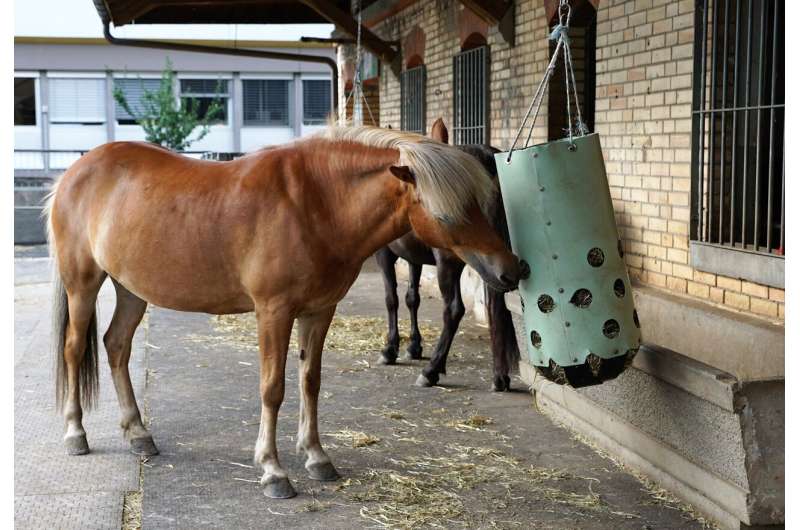This article has been reviewed according to Science X's editorial process and policies. Editors have highlighted the following attributes while ensuring the content's credibility:
fact-checked
trusted source
proofread
Designing biosecurity plans for hobby farms

More and more people are practicing farming because they enjoy the outdoors, animals, and the fruits of their labor as opposed to seeing farming as a primary source of income.
Even though "hobby farming" can be a fun activity, it still requires dedication and careful planning. One important aspect of developing a hobby farm with animals is designing a biosecurity plan, or measures designed to reduce the risk of illness between animal populations.
Dr. Brian Shoemake, a clinical assistant professor at the Texas A&M School of Veterinary Medicine and Biomedical Sciences, said biosecurity planning for hobby farms is all about helping your animals stay healthy.
"Biosecurity for smaller populations of animals is typically a plan to prevent the introduction of disease when adding new animals, whether it is through the use of screening tests for diseases, quarantine periods, or conditions of purchase based on how healthy an animal is," Shoemake explained. "A biosecurity plan is also implemented to make sure that a new animal does not become sick from exposure to other animals."
Tips for adding new animals
When adding new animals to a hobby farm, owners should first consider where they purchase their animals, as some animals can be at a higher risk for carrying diseases.
"Acquiring animals directly from the farm they were born on or from reputable sources—such as a reputable breeder or producer who is raising quality animals—is a good way to reduce risks of biosecurity hazards for hobby farms," Shoemake said. "Animals bought second hand or through events where numerous animals congregate may have had an increased risk of exposure to diseases."
Owners should also work with their veterinarians to determine a new animal's health status as soon as they can after being brought home. In the meantime, Shoemake strongly encourages owners to have a quarantine protocol and designated areas to keep new acquisitions segregated from the herd until their health status can be determined, as there are numerous infectious diseases that an animal can carry without showing symptoms.
"For example, if a veterinarian notices during a routine physical exam that an animal has a snotty nose, they may check for respiratory diseases," Shoemake explained. "It might also mean testing a ruminant for diseases that are not overtly apparent, such as bovine viral diarrhea disease, to guarantee they are not a carrier and won't expose any other ruminants present on the farm."
Since diseases can spread between animals, it's also important to know how to protect both your animals and any potential wildlife visitors from possibly spreading illnesses.
"New additions are fun because you get to bring new animals in, but it's worth looking at what animals are already present and trying to figure out what risk factors they may be exposed to," Shoemake said.
"One such risk factor can be wildlife. For example, deer can carry bovine viral diarrhea disease or Johne's disease, which can spread to ruminants if they come into contact with each other. Also, avian influenza follows migratory bird paths, and if backyard poultry are exposed to migrating flocks that are carrying avian influenza, your poultry can become ill."
Shoemake emphasizes that owners can deter wildlife by using physical barriers, such as fences, or not leaving food out.
Lastly, Shoemake pointed out that some animals should be tested for specific diseases according to federal guidelines, such as pigs who are at risk of being exposed to brucellosis and pseudorabies, highly infectious diseases that are federally regulated to limit the disease from spreading.
Key things to remember
While there are general recommendations for every hobby farmer, it is ultimately the owner's decision on how relaxed or strict their biosecurity plan and practices are based on their overall disease tolerance.
"If owners have an absolute aversion to sick animals, they will need a more strict biosecurity plan that ensures new animals are bought from reputable sources, tested to confirm good health, and appropriately introduced to the rest of the farm," Shoemake said. "On the other hand, owners may have a more relaxed plan if they made the decision to bring animals to the farm regardless of their health status. Still, they will need measures to manage and treat any illnesses."
Nevertheless, adherence to any biosecurity plan is crucial to preventing the spread of disease.
"You can have the best biosecurity plan ever, but if you're not going to adhere to it, it's not going to work," Shoemake said. "A lot of disease incidences or outbreaks typically happen because someone has not followed the plan."
Lastly, biosecurity plans should be updated regularly, especially when new animals or species join the farm or contact with other animals changes.
"Improving a biosecurity plan means having a veterinarian come to the hobby farm to see what's going on and determine any areas or measures that are not biosecure," Shoemake explained. "If you've got goals of expanding the hobby farm, you will need to work with your veterinarian to determine what animals go well together, how to help prevent disease, and what the biosecurity practices are for those animals."
Hobby farm biosecurity is essential to protecting your animals from disease, and by following the biosecurity plan you make with your veterinarian, you can enjoy your hobby and the company of your animals stress-free.
Provided by Texas A&M University




















